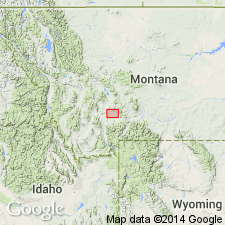
- Usage in publication:
-
- Flathead formation
- Flathead shales
- Modifications:
-
- Original reference
- Dominant lithology:
-
- Shale
- Sandstone
- Limestone
- AAPG geologic province:
-
- Montana folded belt
Summary:
Flathead formation. Divided into Flathead shales above and Flathead quartzite below. The shales are soft, green, shaly beds interlaminated with thin beds of glauconitic limestone; toward base are beds of very dark reddish-brown and green sandstone. Thickness of the shales 290 feet. Overlain by Trilobite limestone, the basal member of Gallatin formation. Fossils. Age is Middle Cambrian. [For description of the quartzite see Flathead quartzite.]
Named from exposures in Flathead Pass, northeastern corner Threeforks [Three Forks] quadrangle, MT.
Source: US geologic names lexicon (USGS Bull. 896, p. 738).

- Usage in publication:
-
- Flathead shales†
- Flathead formation†
- Flathead quartzite
- Modifications:
-
- Overview
Summary:
The use of Flathead in 3 senses being objectionable, the name has for many years been restricted to the quartzite, and the so-called "Flathead shales" have been combined with the overlying trilobite-bearing limestones and OBOLELLA-bearing shales (originally included in Gallatin formation) into a formation named Gros Ventre formation.
Source: US geologic names lexicon (USGS Bull. 896, p. 738).
For more information, please contact Nancy Stamm, Geologic Names Committee Secretary.
Asterisk (*) indicates published by U.S. Geological Survey authors.
"No current usage" (†) implies that a name has been abandoned or has fallen into disuse. Former usage and, if known, replacement name given in parentheses ( ).
Slash (/) indicates name conflicts with nomenclatural guidelines (CSN, 1933; ACSN, 1961, 1970; NACSN, 1983, 2005, 2021). May be explained within brackets ([ ]).

